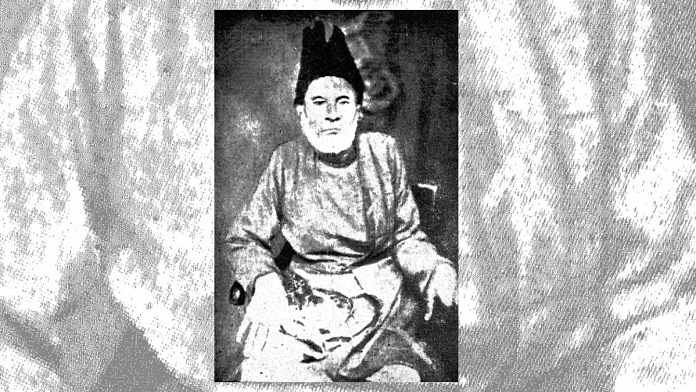Mirza Ghalib, a courtier of the last Mughal emperor Bahadur Shah Zafar, is today remembered as the brightest beacon of Urdu literature.
Poochhte hain woh ki ‘Ghalib’ kaun hai
Koi batlaao ki hum batlaayein kya…
(They ask who ‘Ghalib’ is
Someone tell them, what shall I say?)
So let us tell you. Perhaps no one has come as close to being as synonymous with the literature of a language than Mirza Asadullah Khan ‘Ghalib’ is to Urdu. Maybe not even Shakespeare to English. And that’s not due to any paucity of great writers in Urdu, it is just the brightness of the beacon that was Ghalib.
Ghalib was, truly, the poet who took Urdu to the zenith of its glory as a poetic language.
Born on 27 December 1797, in Agra, Ghalib was a nobleman in the court of the last Mughal emperor, Bahadur Shah Zafar, and was a good friend and poetry coach to Zafar.
He is said to have written his first poem at the age of 11, and by 19, was writing verses that became increasingly incomprehensible to even his contemporaries. He addressed this in the following lines:
Mushqil hai zabas kalaam mera ae dil
Sun sun ke usey sukhanvaraan-e-kaamil
Aasaan kehne ki kartey hain farmaaish
Goyam mushqil vagarna goyam mushqil
(I agree, o heart, that my verse is not easy to take in,
When they hear my work, experienced poets
Tell me I should write something easier to understand,
I have to write what’s difficult, otherwise it is difficult to write.)
And yet, even today, his popularity across the Urdu-Hindustani speaking people of the subcontinent is unparalleled. He is the yardstick against whom a shayar is judged, much like any exceptional cricketer would draw comparisons to Bradman or Tendulkar.
Also read: Urdu sounds are disappearing from Bollywood songs
The pain of Ghalib
By the time Ghalib came to prominence, the Mughal empire was on its last legs. As a result, despite being one of the crown jewels of Zafar’s court, he battled penury and hardship all his life — never being able to own a house, stuck in debt, dependent on a pension from the court and later from the British, denounced as a drunken reprobate, gambler and social outcast.
However, some sources like historian William Dalrymple have said he enjoyed this roguish reputation.
Ye masaayil-e-tasawwuf, ye tera bayaan Ghalib
Tujhe hum wali samajhte, jo na baadakhwaar hota
(These matters of philosophy, these words you speak, O Ghalib
You would’ve been considered God if you weren’t an alcohol drinker)
Ghalib had been married at the age of 13 to Umrao Begum, but it was an unhappy marriage, compounded by the death of seven infant children. He once wrote there was only one pain greater than marriage — the pain of life itself.
This pain echoed throughout his poetry, and is considered one of the key reasons for his resonance with generations of shayari-lovers, alongside his obvious mastery over Urdu and its parent, Persian.
Ghazals like Hazaaron khwahishein aisi and Dil-e-naadaan tujhe hua kya hai are perfect examples of this heady cocktail of pain and wordplay, and windows into the life of their creator.
Also read: R.D. Burman’s magic can make everyone from a grandma to an expat sing along
Representations on screen
There has hardly been a ghazal singer who hasn’t sung Ghalib’s work. But there have been two famous attempts to immortalise him on screen in India — the Bharat Bhushan-Suraiya starrer Mirza Ghalib (1954), whose songs were composed by Ghulam Mohammed, and poet-director Gulzar’s Doordarshan series Mirza Ghalib (1988), starring Naseeruddin Shah, Tanvi Azmi and Neena Gupta, among other accomplished actors.
The television series is considered ghazal maestro Jagjit Singh’s greatest work, as he partnered with wife Chitra Singh to create perhaps the most famous rendition of Ghalib’s poetry.
Gulzar, who almost seems to consider Ghalib his guru, often using his lines or concepts in his own work, penned a brilliant poem in his honour to begin the show — Ballimaran ke mohalle ki wo pecheeda daleelon ki si galiyaan.
Legacy
Two sites associated with Ghalib are now shrines to him — the Ghalib Haveli in Ballimaran, which was bought from local shopkeepers and turned into a walk-in tribute gallery, and his tomb at Nizamuddin, near the tomb of the Sufi saint Hazrat Nizamuddin Auliya.
While he earned fame as a poet in Zafar’s court, it was nothing compared to how the world remembers him today. In his own words,
Hui muddat ke Ghalib mar gaya, par yaad aata hai
Woh har ek baat pe kehna ki yun hota to kya hota.
It has been aeons since Ghalib died, but one remembers
(Him) saying again and again — if it had been that way, then how would it have been?




Very befitting tribute to the famous poet of all ages.